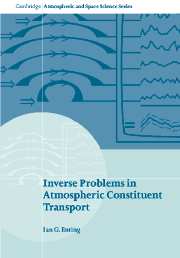Book contents
- Frontmatter
- Contents
- Preface
- Part A Principles
- Part B Recent applications
- Chapter 14 Global carbon dioxide
- Chapter 15 Global methane
- Chapter 16 Halocarbons and other global-scale studies
- Chapter 17 Regional inversions
- Chapter 18 Constraining atmospheric transport
- Chapter 19 Conclusions
- Appendices
- Solutions to exercises
- References
- Index
Chapter 19 - Conclusions
Published online by Cambridge University Press: 05 November 2009
- Frontmatter
- Contents
- Preface
- Part A Principles
- Part B Recent applications
- Chapter 14 Global carbon dioxide
- Chapter 15 Global methane
- Chapter 16 Halocarbons and other global-scale studies
- Chapter 17 Regional inversions
- Chapter 18 Constraining atmospheric transport
- Chapter 19 Conclusions
- Appendices
- Solutions to exercises
- References
- Index
Summary
The end of our Foundation is the knowledge of causes, and the secret motions of things, and the enlarging of the bounds of human empire, to the effecting of all things possible.
Sir Francis Bacon: New Atlantis (1627).Inverse modelling of the atmospheric transport of trace constituents is a rapidly growing field of science. In a little over a decade it has developed from two-dimensional inversions of CO2 sources and sinks to encompass the range of activity described in the preceding chapters. Among the important developments has been the recognition of the ill-conditioned nature of most tracer-inversion problems, particularly in the case of estimating surface fluxes from surface concentrations. This recognition of the ill-conditioning, with associated amplification of errors, emphasises the need for a statistical approach that treats the deduction of trace-gas fluxes and other biogeochemical quantities as problems in statistical estimation.
The main applications of tracer inversion have been for the long-lived constituents, particularly CO2 and CH4. As a consequence, most development of inversion techniques has been of methods that are suitable for such cases and that are oriented to the use of monthly mean data from flask-sampling networks.
The two main types of inversion have been identified as ‘mass-balance’ and ‘synthesis’. The choice between these involves a number of trade-offs such as ease of inversion versus ease of analysis of uncertainty. However, the most important difference is the choice between either assumptions about the degree of spatial variation in the concentration fields (in the case of mass-balance inversions) or assumptions about spatial variation in the source fields (in synthesis inversions).
- Type
- Chapter
- Information
- Inverse Problems in Atmospheric Constituent Transport , pp. 310 - 313Publisher: Cambridge University PressPrint publication year: 2002

